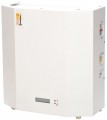Input voltage range
The voltage range at the input of the stabilizer, at which it is able to operate in normal mode and supply a constant voltage of 230 or 400 V to the load (depending on the number of phases, see above). The wider this range — the more versatile the device, the more serious power surges it can extinguish without going beyond the standard operating parameters. However, note that this parameter is not the only, and not even far from the main indicator of the quality of work: a lot also depends on the accuracy of the output voltage and the response speed (see both points below).
Also note that some models may have several modes of operation (for example, with 230 V, 230 V or 240 V output). In this case, the characteristics indicate the "general" input voltage range, from the smallest minimum to the largest maximum; the actual ranges for each particular mode will vary.
In addition, there are stabilizers that can operate outside the nominal input voltage range: with a slight deviation beyond its limits, the device provides relatively safe output indicators (also with some deviations from the nominal 230 or 400 V), but if the drop or rise becomes critical, it works appropriate protection (see below).
Output voltage accuracy (±)
The largest deviation from the nominal output voltage (230 V or 400 V, depending on the number of phases), which the regulator allows when operating in the normal input voltage range (see above). The smaller this deviation, the more efficiently the device works, the more accurately it adapts to “changes in the situation” and the less voltage fluctuations the connected load is exposed to.
When choosing for this parameter, it is worth considering first of all how demanding the connected devices are for voltage stability. On the one hand, high stability is good for any device, on the other hand, it usually means a high price. Accordingly, it usually does not make sense to buy an advanced stabilizer for an unpretentious load like light bulbs and heaters, but for sensitive devices like audio systems or computers, it can be very useful.
Efficiency
The efficiency of the stabilizer is the ratio, expressed as a percentage, between the amount of electricity at the output of the device to the amount of energy at the input. In other words, efficiency describes how much of the energy received from the network the device transfers to the connected load without loss. And losses during operation will be inevitable — firstly, not a single transformer is perfect, and secondly, the control circuits of the stabilizer also require a certain amount of energy to work. At the same time, all these costs are quite small, and even in relatively simple modern models, the efficiency can reach 97-98%.
Installation
—
Wall mounted. This option includes two installation methods. The first, classic option is hanging with the help of “ears” on screws, studs or other similar devices. Thanks to this, the device does not take up space on the floor, in addition, the owner can choose the installation height; this is especially useful in cramped conditions. The disadvantage of this method, compared with the floor, can be called the need to "hollow the walls" and less suitability for moving from place to place; in addition, it is poorly suited for powerful heavy vehicles. The second type of wall-mounted devices are compact low-power models (usually a voltage relay — see "Device"), plugged into a socket not through a wire, but with a plug on the case itself. In fact, such a device is mounted directly on the outlet and does not require special installation.
— Outdoor. Floor models favorably differ from wall models in simplicity and ease of installation: in fact, apart from a flat surface, nothing else is needed for them. The role of such a surface can be played not only by the floor, but also by a shelf, countertop, etc. (the main thing is that such a design can withstand the weight of the stabilizer), and the installation itself is limited only to moving the stabilizer to the desired point in the room. In addition, the ease of moving from place to place is limited only by the mentioned weight, and it can be almost anything. Thanks to this, among the floor
...models there are options for any available power and "tricks". The main disadvantage of this method is the need for space under the stabilizer on the floor or other surface.
Note that some models allow both wall and floor installation as standard. Such a device can be useful, for example, if you have not yet decided on a specific option, or if the situation can change at any time. In addition, it is technically possible to put the wall model on the floor, and equip the floor model with mounts and hang it on the wall, but usually such tricks at least do not make sense, or even lead to unpleasant consequences (such as overheating or breakage of the mounts).
